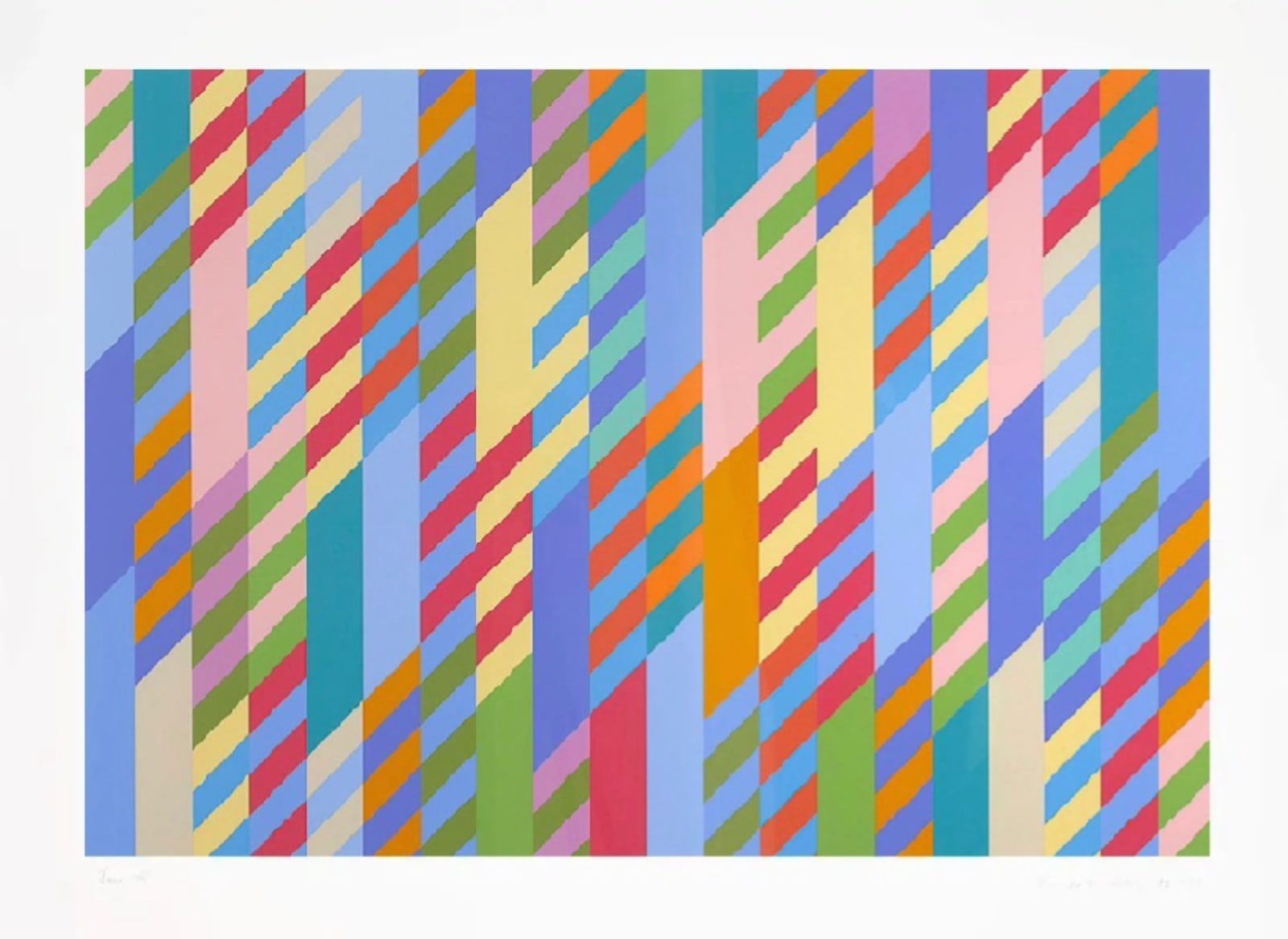Bridget Riley U. K., 1931
June, 1992
Screenprint in colours on wove paper
Signed by the artist in pencil, lower right on recto
Signed by the artist in pencil, lower right on recto
102 × 135 cm
© Bridget Riley
Bridget Riley's 'June' (1992) is a notable work from her acclaimed Zig/Rhomboid series, representing a pivotal moment in her artistic development and showcasing her mastery of colour interaction and optical...
Bridget Riley's 'June' (1992) is a notable work from her acclaimed Zig/Rhomboid series, representing a pivotal moment in her artistic development and showcasing her mastery of colour interaction and optical effects.
In June, Riley employs innovative rhomboid shapes, often referred to as 'zigs' in her studio, to create a sense of movement and depth on a two-dimensional surface. The composition features a meticulously arranged series of diagonal blocks in various colours, such as red, green, blue, yellow, lilac, peach, black, and white. These geometric forms merge, overlap, and interlock at rhythmic intervals, producing a captivating visual symphony that appears to pulse and shift before the viewer's eyes.
This work marks an important evolution in Riley's practice as it illustrates her transition from the thin stripes that defined her earlier optical explorations to a more complex structural approach. Introduced in the mid-1980s, the rhomboid format allowed Riley to delve into a wider array of colour interactions and spatial relationships. She opened up opportunities for richer chromatic interplay and visual dynamism by connecting the shapes via four edges instead of two. June is part of a series that Riley developed between 1986 and 1997, during which she significantly expanded her colour palette. Inspired by a trip to Egypt in 1979-80, Riley adopted what is known as her 'Egyptian palette,' which grew to include over a hundred meticulously mixed tones. This expanded range of colours enabled her to create more nuanced and sophisticated optical effects.
The significance of June in Riley's oeuvre lies in its embodiment of her ongoing exploration of perception, colour theory, and the psychological impact of visual stimuli. It represents a mature phase in her career, merging insights gained from her earlier black-and-white works with her deepening understanding of colour relationships. The composition conveys the artist's ability to create a sense of movement and spatial ambiguity through purely abstract means, challenging viewers' perceptions and actively engaging them in the visual experience.
Moreover, June reflects Riley's enduring interest in the natural world and her intention to capture its rhythms and energies in abstract form. The vibrant, shimmering quality of the piece evokes the play of light and shadow in nature, reminiscent of Riley's childhood memories of swimming in the sea off the coast of Cornwall. As part of the Zig/Rhomboid series, June has solidified Riley's position as a leading figure in Op Art and abstraction. Works from this series are housed in major museums worldwide, underscoring their significance in 20th-century art history.
June exemplifies Riley's relentless innovation, deep engagement with art historical precedents, and unique ability to create visually captivating works that resonate with viewers today.
In June, Riley employs innovative rhomboid shapes, often referred to as 'zigs' in her studio, to create a sense of movement and depth on a two-dimensional surface. The composition features a meticulously arranged series of diagonal blocks in various colours, such as red, green, blue, yellow, lilac, peach, black, and white. These geometric forms merge, overlap, and interlock at rhythmic intervals, producing a captivating visual symphony that appears to pulse and shift before the viewer's eyes.
This work marks an important evolution in Riley's practice as it illustrates her transition from the thin stripes that defined her earlier optical explorations to a more complex structural approach. Introduced in the mid-1980s, the rhomboid format allowed Riley to delve into a wider array of colour interactions and spatial relationships. She opened up opportunities for richer chromatic interplay and visual dynamism by connecting the shapes via four edges instead of two. June is part of a series that Riley developed between 1986 and 1997, during which she significantly expanded her colour palette. Inspired by a trip to Egypt in 1979-80, Riley adopted what is known as her 'Egyptian palette,' which grew to include over a hundred meticulously mixed tones. This expanded range of colours enabled her to create more nuanced and sophisticated optical effects.
The significance of June in Riley's oeuvre lies in its embodiment of her ongoing exploration of perception, colour theory, and the psychological impact of visual stimuli. It represents a mature phase in her career, merging insights gained from her earlier black-and-white works with her deepening understanding of colour relationships. The composition conveys the artist's ability to create a sense of movement and spatial ambiguity through purely abstract means, challenging viewers' perceptions and actively engaging them in the visual experience.
Moreover, June reflects Riley's enduring interest in the natural world and her intention to capture its rhythms and energies in abstract form. The vibrant, shimmering quality of the piece evokes the play of light and shadow in nature, reminiscent of Riley's childhood memories of swimming in the sea off the coast of Cornwall. As part of the Zig/Rhomboid series, June has solidified Riley's position as a leading figure in Op Art and abstraction. Works from this series are housed in major museums worldwide, underscoring their significance in 20th-century art history.
June exemplifies Riley's relentless innovation, deep engagement with art historical precedents, and unique ability to create visually captivating works that resonate with viewers today.
